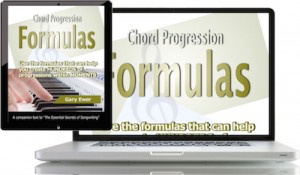Sometimes when I write a blog post that deals with chord progressions, I realize, usually by emails I receive, that the terminology or symbols that I’m using might be confusing or misunderstood. Because chords are such an important part of music in any genre, different ways to describe and name them have developed more or less independently of each other.
 “Chord Progression Formulas” gives you a set of simple formulas from which you can create dozens of progressions in mere moments. It shows you the basics of how chords work, and gives you chords that you can use right away in your own songs. Get it separately, or as part of the 10-eBook Bundle.
“Chord Progression Formulas” gives you a set of simple formulas from which you can create dozens of progressions in mere moments. It shows you the basics of how chords work, and gives you chords that you can use right away in your own songs. Get it separately, or as part of the 10-eBook Bundle.
So if you’re not sure what we mean by “chord inversions”, “minor 7th”, “suspensions” and/or “parallel roots,” I thought I might offer the following short list of chord progression basics to help you as you work out your songs.
- Read “10 Chord Progression Questions and Answers.” Years ago I wrote this short blog post in a bid to help clear up some confusion regarding some of the more commonly used terms with regard to chord progressions. You may want to give that a read.
- Roman numerals. Especially in traditional harmony circles, chords are often identified by using Roman numerals. The reason is that it makes transposing them to any other key a lot easier. This link opens a Wikipedia page that gives some basic information.
- Nashville Number System. This is similar to Roman numerals, and is often used by musicians who work in pop genres. Here’s an article that will give you an idea of how it works.
- Chord Progression Complexity. If you’re looking for ways to make your chords sound more interesting and creative, read this article that I wrote last year: “How to Create Interesting Moments Within Strong Chord Progressions.”
- The Concept of Strong and Fragile Chord Progressions. In my video, “What Are Strong and Fragile Chord Progressions, and How Do I Use Them?”, I’ve defined fragile and strong progressions – what they are, and where they might appear in a song. This is an important concept for strengthening the underlying musical structure of your songs.
- Thinking of Chord Progressions as a Kind of Musical Journey. This recent article,”Chord Progressions: The Journey Away, and the Journey Back Home,” shows you a good way to make longer progressions sound more interesting: by moving from major to minor, and then switching gears to make the trip back to the tonic chord.
As a final bit of advice, I’ve written hundreds of articles on this blog over the past number of years about chord progressions. So in the search bar near the top of this page, simply type “chord progressions”, hit “Return”, and you’ll find many articles, some of which might be addressing the issues you’re facing as a songwriter today.
 Written by Gary Ewer. Follow Gary on Twitter.
Written by Gary Ewer. Follow Gary on Twitter.
 “The Essential Secrets of Songwriting” 10- eBook bundle comes with a free copy of “Creative Chord Progressions”.
“The Essential Secrets of Songwriting” 10- eBook bundle comes with a free copy of “Creative Chord Progressions”.











If you write lyrics only and do not play guitar or piano; you are at quite a
disadvantage Many Many Great Songs in all genres have evolved from an
interesting chord sequence , and Just a basic knowledge of a few simple chords
are easy to learn , and then you expand your knowledge by trial and error